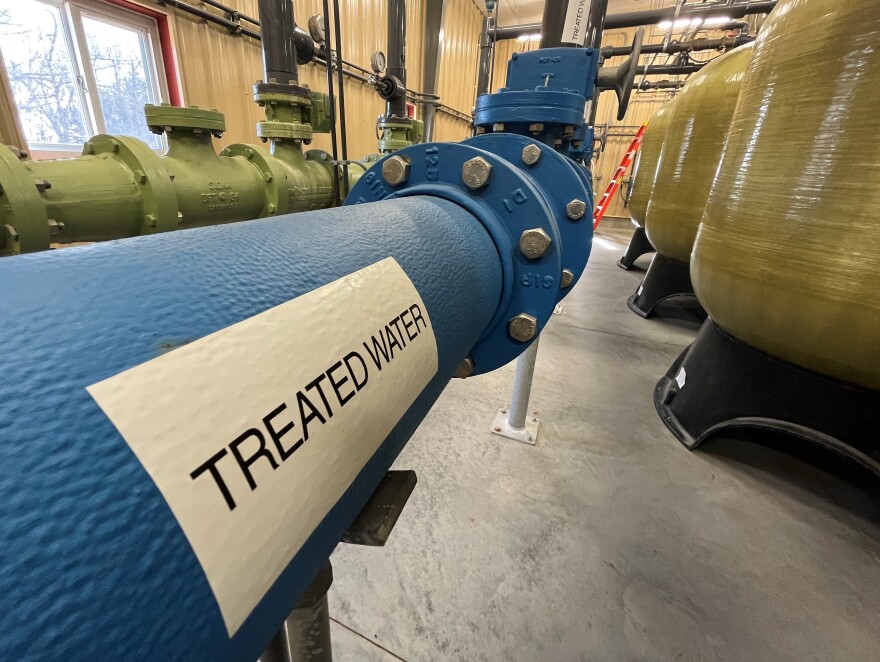HAVILAND, Kansas — Fifteen years ago, Robert Ellis got a letter he never wanted.
Haviland’s drinking water had failed a state safety test. It had more nitrate than federal limits allow. And as mayor of this small town east of Dodge City, it was his job to help the town figure out what to do.
Building a new water treatment plant would cost millions, so the town started installing water filters one home at a time. That penciled out far cheaper than one central plant.
But state regulators told them no. Those in-home filters wouldn’t cut it.
The town pleaded its case in a series of meetings and hearings that lasted years. To no avail. If Haviland didn’t build a plant, Ellis said, the state would have fined the town thousands of dollars a day.
“There was quite a battle,” he said. “But as usual, the government won.”

So after a decade, Haviland finally agreed to build a nitrate removal plant to get its contaminant levels under the limit.
The price tag? $2.4 million — for a town of just 700 people. It was almost as if every last person in Haviland just got a bill for roughly $3,500.
Today, the water in Haviland is cleaner and safer. The regulators are satisfied. But Ellis said when the town’s residents see the plant, they just think about how much it’s costing them.
“They’ve been drinking out of their garden hose all their lives. … They don’t worry about the nitrates,” Ellis said. “All they look at (is) their water bill.”

- Here's how this year's drought has battered the Midwest — and what it might mean for next year
- This city in Kansas really conserves its water, but that still might not be enough to survive
- One year after wildfires, Kansas ranchers vow to ‘get by ... somehow’
- Here are 7 ways this dry, hot year stacks up against the worst droughts in Kansas history
- Western Kansas wheat crops are failing just when the world needs them most
- How the drought killing Kansas corn crops could make you pay more for gas and beef
- Up to 1 million birds count on Kansas wetlands during migration. Drought has left them high and dry
- How Kansas could lose billions in land values as its underground water runs dry
- Kansas wildfire responders brace as a dangerously dry, windy season drags on
- How an increasingly brutal Kansas climate threatens cattle’s health and ranchers' livelihoods
- A hotter, drier climate and dwindling water has more Kansas farmers taking a chance on cotton
Dozens of other small towns across Kansas have found themselves in similar spots in recent years — caught between massive costs and small budgets, between answering to their residents or state regulators, between the way agriculture sustains their economies and the way it channels some chemicals, like nitrates, into their water.
A plant to clean up nitrates cost $1.1 million in Everest, a northeast Kansas town of about 270 people.
St. John in central Kansas spent just under $3 million on a plant to get rid of nitrates for its 1,200 residents.
In Woodston near Hays, the nitrate removal plant cost $1.15 million — for a town of fewer than 100 people.
And more than 30 other rural towns across Kansas still run over the legal limit for everything from nitrates to arsenic to chemical byproducts of the very treatments used to make the water drinkable.
For towns this small, a multimillion-dollar project weighs heavy. Even years later, Haviland’s current mayor, Aaron Stokes, said it “dominates … the conversations we're having.”
“It's hard to do anything else,” he said, “because we've got this thing looming over us.”
And in addition to the price of construction, the Haviland plant — which requires a $5,000 semi-truck load of salt every few months — takes a lot to maintain.

Water bills in Haviland have just about tripled to cover the costs, including repaying a $1.55 million loan the town got from the state. For homes using 5,000 gallons of water, monthly bills went from less than $15 to $42.
City Council President Kay Unruh said it will still take decades for Haviland to pay it all off.
And the most frustrating part, she said, is the town came up with an alternative — those in-home filters — that could have better fit the town’s financial limitations but felt “backed into a corner” when it came to building the plant.
The state didn’t believe Haviland could maintain all those filters spread throughout the town, which includes a senior living center and a college with fewer than 200 on-campus students, even though Unruh said the in-home reverse osmosis filters would have actually removed more nitrate than the plant does.
She described it as another example of the state or federal government not trusting rural Kansans to decide what’s best for themselves.
“Our hands are tied financially because all of our resources are going to comply with these regulations,” Unruh said. “We feel like we’re being strangled.”
Something in the water
People in western Kansas have enjoyed historically cheap tap water that’s drawn from the underground Ogallala aquifer and treated only with chlorine.
“Very few rural water districts have a treatment plant,” Kansas Rural Water Association consultant Bert Zerr said.
If that water stays within federal safety standards, it’s ready for the faucet. But when it goes over the limit, Zerr said, residents’ water bills shoot up.
“If they’re not doubling, they’re close to it,” he said.
Those small-town treatment plants are becoming more common in farm country where more nitrate from fertilizer runoff and cattle feedlot waste makes its way into the ground.
A recent nationwide study from Iowa State University shows the use of nitrogen fertilizer nationwide has increased 34-fold since the 1940s. And agricultural regions from central California and eastern Washington to the Great Plains are home to some of the country’s most likely places for nitrate violations.

Closer to home, a Kansas State University study that tested water wells in rural central Kansas between the 1970s and 2016 found that nitrate levels increased in 95% of those wells.
David Cwiertny, who directs the Center for Health Effects of Environmental Contamination at the University of Iowa, said nitrate levels will likely continue rising until those regions do more to keep the chemical from getting into water supplies in the first place.
“We can’t be surprised that we have increasing levels of nitrate in our water,” Cwiertny said. “We know that we’re putting down increasing amounts of nitrogen on the land.”
So just how dangerous are these chemicals in the water? It’s complicated.
To start, the federal standards for drinking water were set more than two decades ago to guard against severe health consequences — effects that someone would experience shortly after drinking a chemical.
But Cwiertny said even the safety regulations crippling the budgets of so many small towns are likely too loose.
Recent research suggests drinking water with nitrate for years could cause other serious health issues — things like bladder cancer, birth defects and preterm delivery — even at concentrations below the legal limits.
“We know so much more about what chemicals are out there and what the chemicals we know about can do to us,” Cwiertny said. “Our regulations need updating.”

The inevitable
Climate change threatens to make things worse.
As drought becomes more common, farmers pump more water from the aquifer to irrigate crops. And as underground water levels dwindle, the chemicals in that water become more concentrated.
“It's been taken for granted that our water, groundwater especially … you can just take it right out of the tap and not have to be concerned about the quality,” Kansas Farm Bureau public policy director Kent Askren said. “That was probably never the case, but it certainly is not the case today.”
And what about the people adding fertilizer to the ground?
Askren said that while Kansas farmers may not use less fertilizer than they did decades ago, they do have the ability to use it more efficiently thanks to new technology.
Historically high fertilizer prices mean farmers have plenty of reasons to do just that.
“Sometimes the picture is painted that agriculture is just willy nilly out there, throwing this stuff out,” he said. “This is one of their most expensive inputs. … They don't want to waste an ounce of it.”
But even if every farmer stopped fertilizing tomorrow, it could take decades for the nitrates already in Kansas groundwater to dissipate.

And for western Kansas towns that have yet to see chemicals increase in their water, it’s likely just a matter of time before they do.
“I would not be surprised,” Oakley utilities director Rod Huffman said, “especially in the farming community areas, where the stuff that causes it the worst is.”
Three years ago, Huffman received his own dreaded letter from the state. One of Oakley’s water wells had too much nitrate.
So the northwest Kansas town of about 2,000 people had to start giving out bottled water to residents and posting notices around town warning of the potential danger each time it turns on that seasonal well.

The town plans to build a filtration plant, but even if all goes well, that likely won’t be up and running for two years.
And it has already doubled water rates to prepare for the cost. Huffman said monthly water bills in Oakley are now between $70 and $80. That’s higher than the average bill in much larger cities, such as Wichita ($52) and Lawrence ($58).
Oakley could try to push back against the regulations or try to find a temporary solution — like drilling a new well in a spot where nitrate concentrations are lower — that could buy some time.
But Huffman said that as nitrate levels rise regionally, it’s going to keep getting harder to find wells that are under the limit. And if the town doesn’t bite the bullet now, he’s worried it’ll only cost millions more to build a treatment plant in the future.
“It’s not gonna be cheap, but it’s cheaper than not doing nothing at all,” Huffman said. “It’s just not gonna get any better.”
What happens when the drinking water in a very small town gets contaminated... and the only way to fix it costs millions of dollars the town doesn't have?
— David Condos (@davidcondos) March 30, 2022
I visited two #westernkansas towns to hear what it has meant for them and what they think of it all. https://t.co/mIw7xlCQpL
David Condos covers western Kansas for High Plains Public Radio and the Kansas News Service. You can follow him on Twitter @davidcondos.
The Kansas News Service is a collaboration of KCUR, Kansas Public Radio, KMUW and High Plains Public Radio focused on health, the social determinants of health and their connection to public policy.
Kansas News Service stories and photos may be republished by news media at no cost with proper attribution and a link to ksnewsservice.org.








